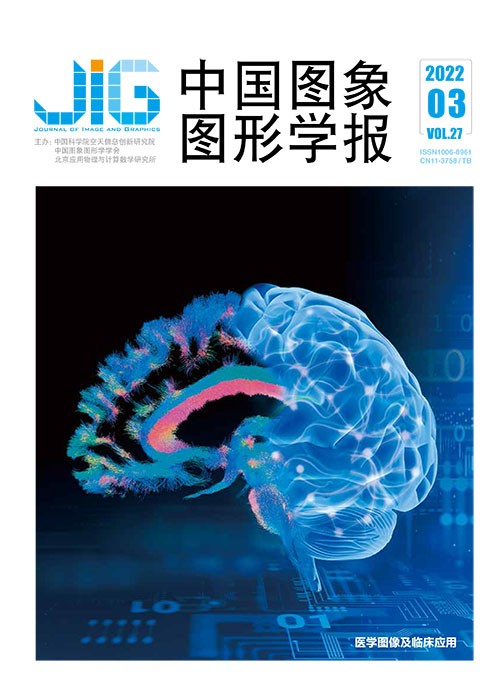
结合目标检测与匹配修正的手腕骨兴趣区域提取
摘 要
目的 在骨龄智能评估研究中,如何准确地提取手腕参照骨的兴趣区域(region of interest,ROI)是保证骨龄精确评估的关键。基于传统深度学习的方法用于手腕骨ROI提取,存在个别参照骨漏判、误判等情况,导致平均提取准确率较低。本文结合目标检测强大的定位和识别能力,以准确提取所有手腕骨ROI为目的,提出了一种参照骨自动匹配与修正方法。方法 针对不同参照骨形状、位置等特征表现出的规律性和关联性,本文采集了大量不同性别、不同年龄段的人手腕图谱作为参照骨样本匹配,然后分多个阶段提取参照骨ROI:1)基于目标检测算法初步提取出所有参照骨候选ROI,并根据一定的阈值剔除置信度较低的区域;2)结合参照骨的大数据样本构建位置点匹配模型,对剔除区域进行自动匹配与填补,保证ROI提取的完整性;3)通过多尺度滑动窗口以及ROI分类模型,对填补得到的ROI位置进行滑动修正,进一步保证提取准确率。结果 实验结果表明,本文结合目标检测与匹配修正的方法优于现有绝大多数方法。其中,匹配修正方法在目标检测算法的提取结果基础上,提升了约1.42%的平均准确率,当结合Faster R-CNN (region-convolutional neural network)算法时能达到最高98.45%的交并比(intersection-over-union,IoU)准确率。结论 本文方法利用手腕骨的位置特征,对个别提取困难的参照骨类型进行重新匹配与修正,有效地弥补了传统方法泛化能力不足的缺点。本文方法能够同时面向人手腕中所有参照骨ROI提取,具备良好的扩展性和易操作性。
关键词
Hand-wrist region of interest extraction based on object detection and matching correction
Mao Keji1, Wang Minhao1, Chen Lijian1,2, Lu Wei1, Wu Kunxiu1, Chen Qingzhang1, Zhao Xiaomin1(1.College of Computer Science & Technology, Zhejiang University of Technology, Hangzhou 310023, China;2.Xiaoshan College, Zhejiang Radio and Television University, Hangzhou 312000, China) Abstract
Objective The regions of interest (ROI) extrancted correction in hand-wrist reference bones is the essential method to target accurate bone age. Current image processing methods have high time complexity and operation difficulty, which cannot meet the requirement of large-scale clinical use. Deep learning technology has its feature extraction priority but the missing and misjudgment of individual reference bones will lead to low average extraction accuracy when it is used to extract ROIs of hand-wrist reference bones. The intensive positioning and classification capability of object detection algorithms is analyzed to demonstrate an automatic reference bone matching and correction method for the purpose of extracting all hand-wrist ROIs accurately.Method The amount of reference bones in the human hand-wrist is clear in common. The identified illustration strict regularity and correlation for the time-scaled bone age. Based on this, a large quantity of human hand-wrist X-ray images have been collected as the benchmark in genders and age scales. As for the evaluation, the reference bone sample orientation can be easily identified to calibrate the reference bone ROI and improve the extraction accuracy further based on matching the position similarity between the sample and the standard atlas. This demonstration is mainly divided into 3 steps:1) All reference bone candidate ROIs are extracted in preliminary based on the object detection algorithm. Due to the insufficient generalization capability of most deep learning models, the accuracy rate is low when extracting some complicated reference bones. Based on the results of the reference bone candidate ROIs generated, this research adds a series of post-processing procedures, including replicated ROIs of the same reference bone category deduction, and filter regions alteration with low confidence in terms of the threshold set by the algorithm; 2) In order to guarantee the overall capability of the reference bone ROI extraction, it is necessary to match automatically and refill the deducted regions of the sample. First, while the skeletal development process of different human hand-wrists is similar, the distribution of reference bones in the same skeletal region is also strictly regular. It is of great value to use the large data atlas of reference bones to evaluate the sample's ROI. Hence, the human hand-wrist is segmented into 4 individual skeletal regions in terms of the bone growth characteristics. Different skeletal regions are matched and corrected independently. Next, a location-point matching model sorted out the most similar changeable features, such as the shape and position of the deducted region based on the big data standardized atlas of reference bones and choose it as the reference bone ROI that is missing from the sample; 3) The generated ROI cannot guarantee high-coordinated accuracy, it is required to optimize the location coordinates for a higher extraction accuracy further based on the refilled ROI result. On the basis of the refilled ROI coordinates, all possible regions of the reference bone category in the hand-wrist are categorized via a multi-scale sliding window and construct the ROI classification model to generate the possibility of the current reference bone in the window region. The region with the highest confidence is altered as the revised reference bone ROI. The basic network structure of AlexNet is demonstrated in the ROI classification model, which includes five convolutional layers and three fully connected layers.Moreover, the image augmentation method is applied to generate all positive and negative samples of the reference bone ROIs for model training. At the end, the trained model is applied in to verify its classification effect in the testing set. Result The demonstrated results illustrated that the intergrated method of object detection and matching correction algorithms has its priority. The ROI classification model application can achieve a classification accuracy of more than 99% for all 14 reference bones. When the location-point matching model is used to correct a single reference bone ROI in different skeletal regions, it can reach an average of 92.56% accuracy. The integrated matching correction method combining with proposed models can improve the average accuracy of 1.42% based on the extraction results from the object detection algorithms. The average accuracy of faster region-convolutional neural network (Faster R-CNN), you only look once v3(YOLOv3), and single shot multibox detector(SSD) has increased by 0.54%, 2.48% and 1.23%, respectively. Based on the Faster R-CNN algorithm intergration, it can reach the highest 98.45% intersection-over-union (IoU) accuracy rate. The calculated IoU value is greater than or equal to 0.75, the currently predicted candidate region is assessed as the correct region. Conclusion In terms of the location features of the hand-wrist reference bones, this method can re-match and correct the individual reference bone categories that are difficult to extract. Following sufficient data atlas of other reference bone categories, this method can be further applied to multiple bone age scoring methods including the TW3 and RUS-CHN method.
Keywords
|



 中国图象图形学报 │ 京ICP备05080539号-4 │ 本系统由
中国图象图形学报 │ 京ICP备05080539号-4 │ 本系统由